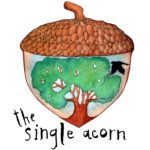
Episode description:
There is a growing body of evidence that illuminates just how deeply and complexly interconnected organisms are to one another. As scientists uncover these interdependencies, we’re beginning to see how fundamentally different our world would be without symbioses. We would not have the forests of today with mycorrhizal connections running through the soil, we would not have cows, termites, or rabbits without the powerful digestive processes of bacteria, and we wouldn’t even have multicellular life if not for symbiotic bacteria that power photosynthesis (chloroplasts) and metabolism (mitochondria). Many of these lasting interactions across species lines are beneficial to both organisms involved (symbionts), but in the everlasting evolutionary arms race to survive long enough to produce offspring, organisms have devised endless adaptations to exploit other species. Welcome to the Single Acorn.
Produced by: Crow’s Path
Hosted by: Professor Eweagey (aka Teage O’Connor), Glenn Etter, Dr. Christine Fleener
Supported by: Our patrons @ patreon.com/CrowsPath
For more natural history:
- Subscribe to the Wild Burlington Newsletter @ crowspath.org/newsletter
- Follow our blog: crowspath.org/blog
- Follow us on instagram: @crowspathvt
Theme music by: Jake Weiss
Logo design by: Caitlin LaDulce
Ads by: Sara Siegel
WORKS CITED
- Selection for pollination success and the mechanical fit of Impatiens flowers around bumblebee bodies (link)
- Ant-mediated seed dispersal alters pattern of relatedness in a population of Trillium grandiflorum (link)
- Melittophily and malacophily in Ipomoea pes-caprae (link)
- Revising a classic butterfly mimicry scenario: demonstration of Müllerian mimicry between Florida viceroys (Limenitis archippus floridensis) and queens (Danaus gilippus berenice) (link)
- Why do some thorny plants resemble green zebras? (link)
- Eating Tapeworms for Weight Loss (link)







